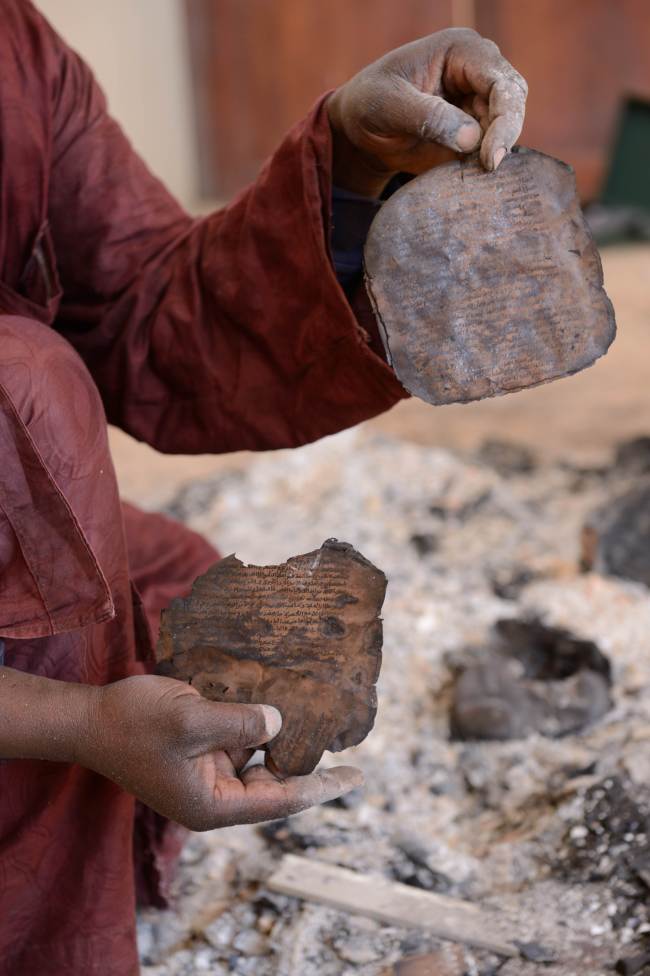Rage in Timbuktu over priceless destroyed manuscripts
By Korea HeraldPublished : Jan. 30, 2013 - 20:21

TIMBUKTU, Mali (AFP) ― “They are not Muslims, they are bandits!” raged Mohamed Elher Ag Abba, whose house flanks a famed archive in Timbuktu where retreating Islamists burnt priceless ancient books and manuscripts before fleeing.
There was outrage around the world at the last defiant act of vandalism by the radicals in this fabled city as they fled a French-led offensive on their northern bastion that ended their 10-month occupation.
The pickaxes and shovels wielded time and again by militants from Ansar Dine (Defenders of the Faith) against what they consider idolatrous shrines, erased part of the heritage of Timbuktu, founded between the fifth and 11th centuries by Tuareg desert nomads.
Their final act of random destruction targeted the precious books, which they stacked in the courtyard of the centre and burnt on Friday evening before leaving the city, residents said.
Timbuktu mayor Halley Ousmane has described the arson at the Ahmed Baba Centre for Documentation and Research as a “real cultural crime.”
Set up in 1973, the centre housed between 60,000 and 100,000 manuscripts, according to Mali’s culture ministry. However experts believe many of the documents may have been smuggled out and hidden when the crisis began.
The tomes, mostly in Arabic and Fula ― a language widely spoken across west Africa ― covered a variety of subjects: astronomy, botany, music, law, history and politics.
Timbuktu was for centuries a key centre of Islamic learning and a byword for exotic remoteness in the Western imagination.
Known as “the City of 333 Saints” or “The Pearl of the Desert,” it was listed as a UNESCO world heritage site in 1988 and has long attracted tourists for its magnificent mud-built mosques and shrines.
Ansar Dine, which follows the hardline Wahhabi strain of Islam, began destroying the cultural treasures in the city in July believing them to be “haram” or forbidden.
A local journalist said the occupiers had razed the shrines of 10 saints.
But several others, located in the well-guarded and sprawling properties of the local gentry, have escaped destruction.
Only the ones that were prominent were targeted. The best-known was the mausoleum of Sidi Mahmoud Ben Amar, who founded the city’s first university in the 12th century.
“It’s the most symbolic as we say Sidi Mahmoud is the protector of the north,” said local theologian Mahamalmoudou Tandina.
The desolate scenes are replicated at the mausoleum of Alpha Moya, the “protector of the east” and Sidi Moctar, the “protector of the north-east.”
Timbuktu’s heyday as an ancient trading hub, intellectual center and cosmopolitan crossroads in the desert vanished under the Islamist occupation.
The trade of gold, salt, ivory and books made it the richest region in west Africa. It attracted scholars, engineers and architects from across the continent, growing into a major centre of Islamic culture by the 14th century.
From the jewel of the ancient Malian Empire (1230-1600), which once spanned most of western Africa, Timbuktu fell back into Tuareg hands and later formed part of the Songhai Empire, one of the world’s largest Islamic empires.
There was outrage around the world at the last defiant act of vandalism by the radicals in this fabled city as they fled a French-led offensive on their northern bastion that ended their 10-month occupation.
The pickaxes and shovels wielded time and again by militants from Ansar Dine (Defenders of the Faith) against what they consider idolatrous shrines, erased part of the heritage of Timbuktu, founded between the fifth and 11th centuries by Tuareg desert nomads.
Their final act of random destruction targeted the precious books, which they stacked in the courtyard of the centre and burnt on Friday evening before leaving the city, residents said.
Timbuktu mayor Halley Ousmane has described the arson at the Ahmed Baba Centre for Documentation and Research as a “real cultural crime.”
Set up in 1973, the centre housed between 60,000 and 100,000 manuscripts, according to Mali’s culture ministry. However experts believe many of the documents may have been smuggled out and hidden when the crisis began.
The tomes, mostly in Arabic and Fula ― a language widely spoken across west Africa ― covered a variety of subjects: astronomy, botany, music, law, history and politics.
Timbuktu was for centuries a key centre of Islamic learning and a byword for exotic remoteness in the Western imagination.
Known as “the City of 333 Saints” or “The Pearl of the Desert,” it was listed as a UNESCO world heritage site in 1988 and has long attracted tourists for its magnificent mud-built mosques and shrines.
Ansar Dine, which follows the hardline Wahhabi strain of Islam, began destroying the cultural treasures in the city in July believing them to be “haram” or forbidden.
A local journalist said the occupiers had razed the shrines of 10 saints.
But several others, located in the well-guarded and sprawling properties of the local gentry, have escaped destruction.
Only the ones that were prominent were targeted. The best-known was the mausoleum of Sidi Mahmoud Ben Amar, who founded the city’s first university in the 12th century.
“It’s the most symbolic as we say Sidi Mahmoud is the protector of the north,” said local theologian Mahamalmoudou Tandina.
The desolate scenes are replicated at the mausoleum of Alpha Moya, the “protector of the east” and Sidi Moctar, the “protector of the north-east.”
Timbuktu’s heyday as an ancient trading hub, intellectual center and cosmopolitan crossroads in the desert vanished under the Islamist occupation.
The trade of gold, salt, ivory and books made it the richest region in west Africa. It attracted scholars, engineers and architects from across the continent, growing into a major centre of Islamic culture by the 14th century.
From the jewel of the ancient Malian Empire (1230-1600), which once spanned most of western Africa, Timbuktu fell back into Tuareg hands and later formed part of the Songhai Empire, one of the world’s largest Islamic empires.
-
Articles by Korea Herald




![[Music in drama] Rekindle a love that slipped through your fingers](http://res.heraldm.com/phpwas/restmb_idxmake.php?idx=644&simg=/content/image/2024/05/01/20240501050484_0.jpg&u=20240501151646)

![[New faces of Assembly] Architect behind ‘audacious initiative’ believes in denuclearized North Korea](http://res.heraldm.com/phpwas/restmb_idxmake.php?idx=644&simg=/content/image/2024/05/01/20240501050627_0.jpg&u=20240502093000)


![[KH Explains] Will alternative trading platform shake up Korean stock market?](http://res.heraldm.com/phpwas/restmb_idxmake.php?idx=644&simg=/content/image/2024/05/01/20240501050557_0.jpg&u=20240501161906)









